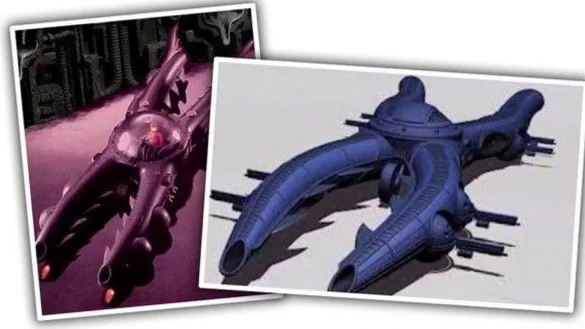An H.R. Giger Batmobile. It’s a name that at once seems like a delicious mix for the character, but also feels like a huge departure for the movie it’s associated with. When Giger was approached to design the Batmobile it was for probably the most commercially minded movie in the franchise, Batman Forever (1995). And now digital artist Leon Gor has given us a more three-dimensional glimpse at how it would’ve looked.
Anyone familiar with the work of H.R. Giger will think of a dark, disturbing style in airbrush paints blending human form and machines in what came to be known as biomechanical. He first began working professionally in 1969, but it was his painting Necronom IV in 1976 featuring a curled-up alien with a long backward-reaching skull which led to him being hired as a concept designer for Ridley Scott’s sci-fi horror masterpiece Alien (1979). It was a movie franchise association that lasted his career, as well concept work on movies such as Species (1995), and an abandoned version of Dune, plus commercial projects and artbooks that all featured his signature style.
The change in direction of tone between Tim Burton’s and Joel Schumacher’s version of the Batman universe came about because Warner Bros. were looking for a style that they felt would be more commercial – less unsettling for younger viewers and that would appease the marketing might of the toymakers. Famously, McDonalds recalled their tie-in toy line for Batman Returns (1992). Schumacher’s two Batman movies are characterized by big A-list actors, neon colors and tongue-in-cheek action. Considering the enormous amount of design work on the Schumacher movies, it seems that the most radical decision to cause a stir was adding nipples to the Batsuit. It’s therefore astonishing to discover that H.R Giger had been approached for concept designs.
So what were the seeds behind this apparently contradictory approach? The answer is in the development journey between the second and third films. Plans were made for Robin to make a cameo appearance in Batman Returns, (to be played by Marlon Wayans) and while the level of Tim Burton’s involvement in the proposed third movie was still being considered, there were clearly plans afoot. The Riddler was an early suggestion as a villain (with Robin Williams apparently in talks), but so too was Scarecrow.
While the idea of Scarecrow in a Tim Burton movie seems tantalizing, even as he departed from the project, the plan to include the villain persisted, and H.R. Giger was approached to design a Batmobile that would be appropriate for an attack from Scarecrow’s nightmare-inducing chemical weapons. And so we’re left with this strange stretched out X, looking like an underwater creature. Wicked blades feature between the arms, and the sketches suggest that the front arms, at least, come together. There also appear to be guns protruding from pods that could be the wheels.

Leon Gor is a product designer working in the games industry. During his time working at Morpheus International as a graphic designer, he became fascinated with the book that they published entitled H.R. Giger’s Film Design which included the unused Batmobile designs. He says on his Deviant Art page:
The 3D model is a composite design based on his sketches and my attempts to rationalize the design into a “real” working vehicle. I theorized that the design could possibly work if each spherical wheel contained its own individual motor/transmission system. The wheels would operate in unison. This would allow the Batmobile forwards/backwards/sideways and 360 movement. The machine guns would fire rubber bullets/tear gas and can individually tilt up/down and travel sideways in a 160 degree arc.
Giger’s designs are dated 1994. With Batman Forever released in June 1995 – without the inclusion of Scarecrow, of course – it demonstrates how ideas were being developed and discarded late into pre-production. The designs were requested by Schumacher which suggests that he was quite prepared to allow a little darkness into the franchise. It’s a shame that, for all its blockbuster merits, decisions were made to tone down the film’s darkness.
With the Knight Terrors event story sweeping through DC comics at the moment, we can dream of Batman being such a familiar and established sight in movies that filmmakers feel they can experiment enough with the character in the way that the comics do. We’ll never get to see a Batman movie designed by H.R. Giger because he died in 2014, but comic fans know the Batman universe is robust enough to explore with radical interpretations.
Images credit: DC/Warner Brothers. Story source: Creative Bloq.


